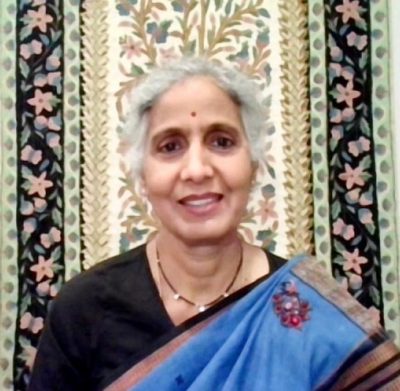
Carnatic Compositions – The Essence and Embodiment
–Aparna Munukutla Gunupudi
Our intent for this essay is to highlight the great features of the language, emotion and melody (rAgam) of a krithi (song/composition) and also to provide the song for your listening pleasure. Most of you may know these krithis, but when you discover the distinct features of a krithi, you may enjoy a new beauty or an attribute in the krithi.
Note: Krithi is defined as a song containing pallavi, anupallavi and charanam that have high musical value and can be sung elaborately with improvisations. Whereas, Keerthana also has a pallavi, anupallavi and charanam but is sung in a single form or simpler pattern.
As we celebrate Guru/Vyasa PurNima this month, we present a krithi in praise of the guru by Muthuswami Deekshitar and a krithi in which a pupil asks to provide wisdom/knowledge by Tyagaraja.
Krithi: srI GurunA Palitosmi
rAgam: pADi
tAlam: Rupaka talam
Composer: Mutthuswami Deekshitar
Pallavi
shrI guruNA pAlitOsmi saccidAnanda nAthEna
anupallavi
AgamAdi sannutEna akhila visva
vanditEna tyAgarAja vibhAtEna tApatrayAritena
caraNam
vedAntArtha vedyEna vikalpa roga vaidyEna nAdAnta supAdyEna nava nAthenAdyEna
sAdAkya kalAkarENa sadAshivAvatarENa nAdAnta vihArENa nava cakrAdhArENa
pAdAmbujEna varENa bhedAdi vidArENa Adi guruguhaparENa kAdi matam anusArENa
Meaning:
shrI guruNA – Teacher
pAlitOsmi – conduct me
saccidAnanda nAthEna – lord of the chidananda(Siva)
AgamAdi sannutEna – you are praised by the learned
akhila vishva vanditEna- bowed by the entire universe
tyAgarAja vibhAtEna – praised by Tyagaraja
tApatrayAritena – reducer of the three miseries
vedAntArtha vedyEna – the one that can explain the meaning of the vedantas
vikalpa roga vaidyEna – the one who can treat the illnesses
nAdAnta supAdyEna – the one who is in the form of nAda
nava nAthenAdyEna – the first lord of nava chakras
sAdAkya kalAkarENa – one with the arms that give wealth of fine arts
sadAshivAvatarENa – the one who is an embodiment of lord Siva
nAdAnta vihArENa – the one who dwells in the nAda
nava cakrAdhArENa – the one who is pivotal for 9 chakras
pAdAmbujEna varENa – his lotus feet
bhedAdi vidArENa – remover of differences
Adi guruguhaparENa – who protects Guruguha
kAdi matam anusArENa – the one who follows religions created by people with desires
The antya prAsa in this krithi is incredible and so meaningful. Guru/teacher is the most important person in everybody’s life. A teacher imparts the necessary knowledge and allows the pupil to ascend a path to success. In this krithi, Deekshitar not only describes the qualities of a teacher but also refers to him as an embodiment of lord Siva. He begs the ever contented guru to bless him. He says a guru is praised by the learned, worshiped by the people around the world, revered by Tyagaraja, and the remover of three miseries caused by the mind, natural disasters and acts of god (adhyatmika, adhibhoutika and adhidaivika). In charanam, he describes Guru as the one who can explain the vedas and vedantas, who can cure the illnesses, the one who relishes the nectar of “Naada”, who is the first of the navanath (navanathas are the nine gurus believed to be incarnations of lord Narayana), the one who is skilled in art, the one who is the embodiment of lord Siva, the one who dwells in the “Naada”, the one who is pivotal for the nava chakras (bhupuramu, shodasa, ashtadala, chaturdasaara, dasa trikona, antardasaara, ashtakona, trikona and binduvu”), the one that has lotus feet, the one who removes the differences, the one who blesses guruguha and the one who follows the religions that were created by the people. Siva is considered as the first guru (Adi guru) noted by teaching yoga sastra to the sapta rishis (the seven sages – MarIchi, AngIrasa, Atri, Poulastya, Pulaha, Kratuvu and Vasishta) on the full moon day in the month of Ashadha which is celebrated as guru poornima across India by Hindus.
This krithi describes the teacher in many ways. It is set in the ragam pADi, which is sung in the early morning hours. It is said that the best learning takes place in the early morning (Brahma muhurtham) and that is why many gurukulams make students chant the vedas in the morning. It is interesting to find the choice of one of the morning ragas for this song by Deekshitar.
***
Krithi: GnAnamosagarAda
rAgam: Poorvi KalyaNi
tAlam: Rupaka talam
Composer: Tyagaraju
pallavi
GnAna mosaga rAdA garuDa gamana vAdA
anupallavi
nI nAmamuchE nAmadi nirmalamainadi
caraNam
paramAtmuDu jIvAtmuDu padunAlugu lOkamulu nara kinnera kimpurushulu nAradAdi munulu
paripUrNa nishkaLanka niravadhi sukha dAyaka vara tyAgarAjarchita varamu tAnanE
Meaning:
GnAna mosaga rAdA – please give me the wisdom
garuDa gamana – the one travels on the garuda (eagle)
vADA – why argue
nI nAmamuchE – with your name
nAmadi – my heart/mind
Nirmalamainadi – has become pure
paramAtmuDu – supreme soul
jIvAtmuDu – the soul in the self
padunAlugu lOkamulu – fourteen worlds
nara – humans
kinnera kimpurushulu = celestial bodies
nAradAdi munulu – nArada and other sages
paripUrNa nishkaLanka – completely perfect/unblemished
niravadhi sukha dAyaka – provider of constant bliss
vara tyAgarAjarchita – worshiped by tyagaraja
varamu tAnanE – grant me the realization that I am the paramatma
In this song, Tyagaraja refers to lord Vishnu as his Guru and begs to teach him the knowledge and realization of Jeevatma and paramatma. He requests the lord Vishnu (one who rides the eagle) to imbibe the knowledge without argument. In anupallavi, he says that his mind is clear and pure from chanting lord Vishnu’s name. Then in charanam, he says “oh perfect lord, you are the provider of constant bliss, please bless me with the boon of realizing that I myself am the jeevatma, paramatma, kinnera, kimpurusha and the inhabitants of the fourteen worlds. In other words, realizing the concept of paramatma makes one to understand the supreme soul’s pervasiveness in this universe as paramatma is omnipresent.
Guru is a Sanskrit word that by definition means remover of darkness (“gu” is darkness “ru” is remover). On the occasion of guru poornima this month, we take this opportunity to praise and thank all of our gurus and inspire all the students to seek and gain more academic as well as spiritual knowledge. And we present these two songs that signify the importance of guru and the aspirations of a student by a noted teacher Sri. Arvind and his disciple Ranjani.
The power of music is profound
The joy of music is sweet and sound
The awe of music is abound
Music makes the world go round
Arvind Lakshmikanthan is an accomplished violinist. He performs as a soloist and has accompanied several acclaimed musicians. Having performed in concerts extensively in the US and in India, he has trained several students in music.
Ranjani Gunupudi works as a senior statistician and is a disciple of Sri Arvind Lakshmikanthan. She resides in the San Francisco bay area.
*****

Aparna Munukutla Gunupudi is a poet, lyricist and short story writer. She has written dance ballets such as Queen of Jhansi, Prasanna Ashtalakshmi, Usha Kalyanam, Sneham, Jamsetji Tata and they were performed in Kuchipudi and Bharatanatyam styles. She wrote songs for “Prema Tarangini” an audio cassette released by noted music director Sri Manohar Murthy. She considers her parents, who provided and encouraged her in book reading, are her “gurus” and Sri Jandhyala Payayya Sastri as her writing mentor.
